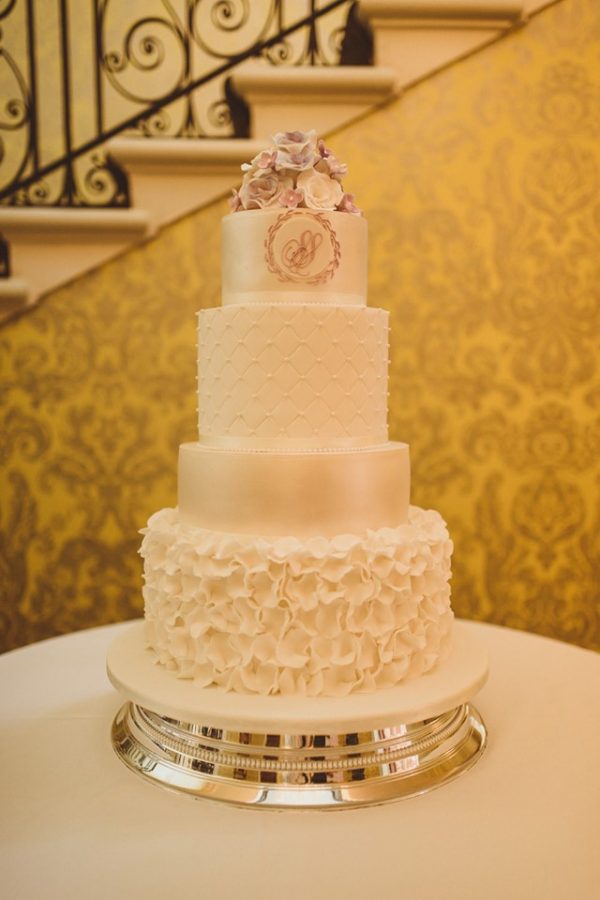
by Michael | Feb 24, 2020 | Blog
With it
being Shrove Tuesday today, my thoughts – not unnaturally – have turned to food
and drink. Obviously, today is technically a religious day, and many religions feature
food and drink in their festivals. None more so than Judaism, I’d say.
One example
is due in a matter of a week or two. That is the festival of Purim, and the
eating of hamantaschen – Haman’s ears, or poppy-seed parcels – is closely
associated with this. (Haman is the villain of the story.)
I don’t often conduct full religious ceremonies, but, every so often my services include some emphasis on food or drink. Perhaps that will give you an appetite (sorry!) to include something similar in your ceremony.
Drink
A
very popular, simple ritual at a wedding can be the Loving Cup. In this case, a
goblet of wine (or whatever drink the couple prefer) is prepared. Bride and
groom will sip three times from the goblet, passing it to each other each time.
I ask them
to drink to the love they’ve shared in the past. Next, to drink to their love
in the present, on this their wedding day. And finally to drink
to their love in the future and forever more.
On one memorable occasion the groom was extremely nervous. He took the
invitation to ‘sip’ to mean ‘gulp’. The alcohol clearly went to his head and he
became very relaxed and amusing for the rest of the ceremony!
Food
Although this can only be relevant to a limited number of readers, a
lovely ritual I have witnessed comes from Russia.
The bride’s mother bakes a large plaited loaf of bread. At the appointed
time, both bride and groom start eating it – from the opposite ends. They take
one bite each.
My role was to ask the guests to judge who took the bigger piece and I pointed
out that whoever
gets the bigger piece will be assured to be the head of the household! (I think
the bride always wins!)
So, as you tuck into your pancakes, give some thought to the value of food and drink! If you want to talk to me about rituals, then feel free!
Photo: Matt Penberthy
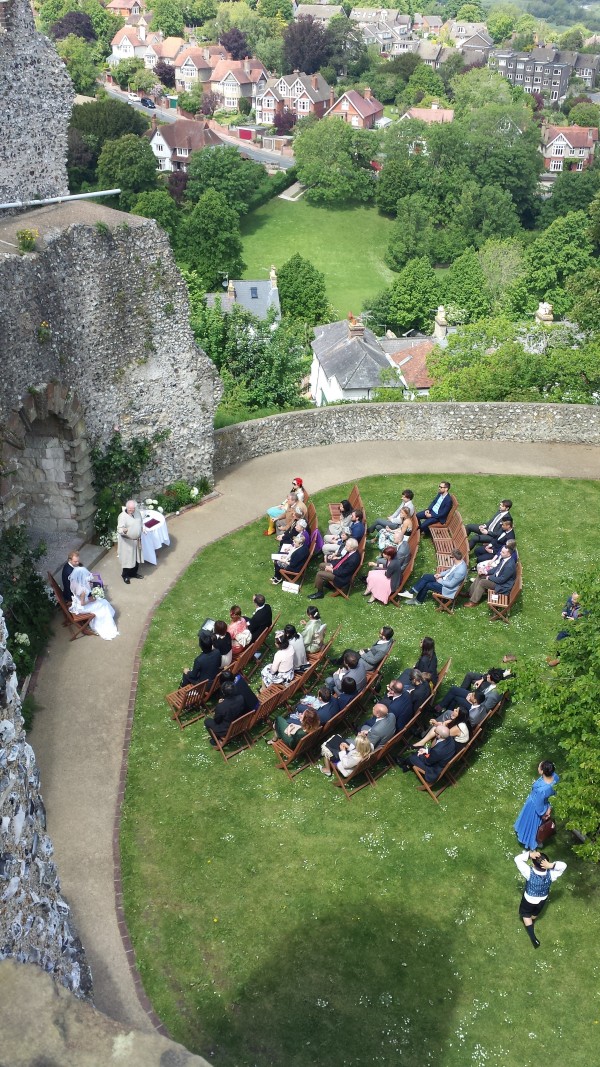
by Michael | Dec 4, 2018 | Blog
Celebrating a big event? Something special? Would you consider a quirky ceremony?
Surely a wedding or something needs to be religious? Or conventional, at least?
Of course, it can be. But that’s not to say that it can’t be a quirky ceremony. (Or partly quirky!)
After all, it’s your day, so you don’t have to be beholden to what other people think or expect.
I’m not suggesting that you should be tasteless or offensive – but you can be different. There is huge scope for creativity. It doesn’t take so much effort to come up with a memorable, meaningful and beautiful ceremony. And for all the help you will need, a civil celebrant can be there, with ideas and guidance. They are professionals and can really point you in the right direction.
So what do we mean by “quirky”?
The venue can be anywhere (subject to permission and possible payment!). I’ve conducted ceremonies at Stonehenge, by a canal, at the Savoy, atop an Iron Age fort, in a back garden, in a field – and the list goes on! You are only limited by your imagination (and purse)!
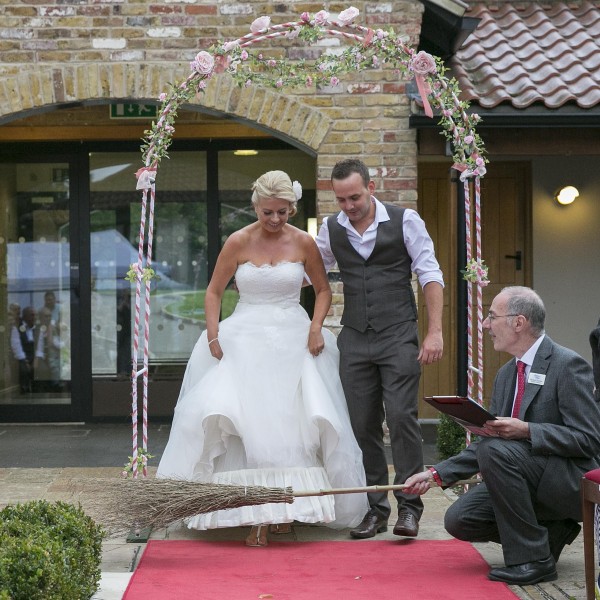
Rituals
Part of the ceremony can be something a little offbeat. You’ve probably read about handfastings in my blogs (eg https://vowsthatwow.co.uk/handfasting-whats-that/). That might appeal.
A ritual that brings a smile to a wedding is “Jumping the Broom”. The couple together jump over a besom (accompanied by appropriate words) to symbolise sweeping in the new.
You may opt for a rose ceremony. Or there’s the Unity Sand option, which is lovely. Both partners simultaneously pour sand in the colour of their individual choice into one larger bottle, so that the colours merge, just as their lives will.
Readings & Music
The content of the ceremony is ‘up for grabs’ too. The tone is up to you. There is no compulsion to include heavy, serious readings, if you don’t want them. Why not have a humorous poem or text, or even several?
Choose who will read – or even sing – for you.
Similarly, while there’s absolutely nothing wrong with having a serious, classical piece played, your tastes may actually be rather different. So by all means let the music reflect these.
Your story, your vows
Personally, I welcome the opportunity to make ceremonies that I conduct as personal as possible. I believe the guests enjoy and appreciate this a lot too.
One feature I like to include, therefore, is what I call the couple’s “story”. In the case of a wedding, it might be how they met, adversity they had to overcome, and what attracted them to each other.
Another way they can personalise their ceremony is to write and declare their own vows. For a Vow Renewal, maybe the couple would rewrite their vows, or prepare something about key moments in their relationship.
Although I’m always there to guide and advise, I think it’s best if the couple actually write this part themselves, if possible.
So I hope you now see that there’s nothing wrong with individualising your ceremonies – indeed, this can often make all the difference to the proceedings.
Go quirky!

by Michael | Sep 13, 2018 | Blog
So many people assume that a wedding can’t be creative. It’s either got to be a full religious service or a register office ceremony. Or so they think.
Provided you ensure the legal formalities are complied with, you can have a creative ceremony.
What do I mean by “creative”? That’s a huge question.
For example, you need to consider whether you plan to hold the ceremony indoors or out. How conventional do you want it? What about a wacky venue? On the seashore, at an aquarium, in a hot-air balloon. You get the picture …
Wide-ranging
To speak fairly generally, you can hold a fairly traditional ceremony that, to all intents and purposes, looks like the wedding my grandparents would have expected (except that it might not be held in a religious edifice).
You may opt for a pagan ceremony or some pagan elements. A handfasting will invoke nature blessings and can be most exciting.
Then there are various gradations of religiosity. You could have a few prayers and blessings, some originating from other liturgies or cultures, and of course it might be a humanist-type wedding, with no religious words at all.
A Civil Celebrant-led wedding can cover any degree of religiousness, but your choices don’t end there. There’s the tone and language to be used (by which I mean formal or informal), there’s the music to be decided, what readings or poems will be used, and, indeed, whether you want friends or family participating.
Perhaps the element that differentiates weddings the most is the choice of ritual. That could be another blog in itself! However, maybe this will give you an idea what I am driving at.
Depending on personal beliefs and preferences, you can include rituals from your own or other religions. An East European ritual, for example, involves the couple being presented (usually by a mother) with a loaf of bread. They both bite into it simultaneously, and the person who gets the greater piece will supposedly become the head of the household!
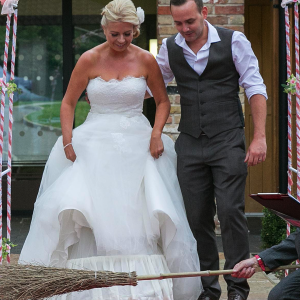
One of my favourite rituals normally comes at the end of the ceremony, is pagan, and can bring a smile to everyone’s face. (But it has slave origins, so not everyone will go for it.) It’s called “jumping the broom” because the couple have to jump together over a besom. This symbolises sweeping out the old and bringing in the new, as they start their life together.
For further suggestions, feel free to contact me!
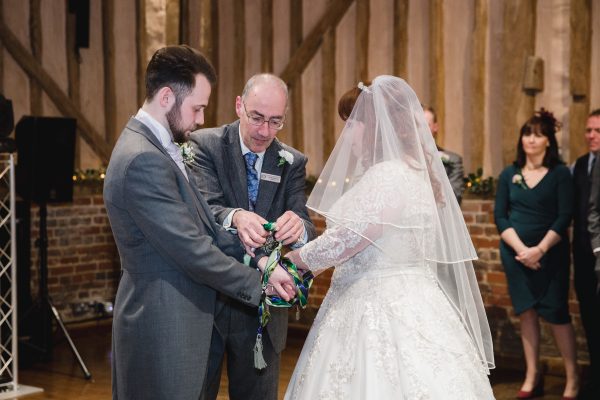
by Michael | Jan 22, 2018 | Blog
Rituals can add dramatically to the atmosphere and spirituality of a ceremony. As a civil celebrant, I am often asked for suggestions as to items that can enhance the service.
I am going to leave out religious rituals, although I do readily incorporate some, especially in mixed-faith services. For one thing, there are rather a lot of religions to mention, and I only have a few hundred words at my disposal!
There is a whole range of rituals that may appeal, so, although I’m only covering a few here, please be aware that the list is by no means exhaustive.
Moreover, there are variants to most of the rituals, so there may not be a ‘right or wrong’ way of doing them.
Handfasting
Probably my most requested ritual is handfasting. You may not know that the expression “tying the knot” is derived from this. The couple take each other’s hands, left to left and right to right. To the accompaniment of suitable words, the celebrant knots the couple’s chosen ribbons or cords (often in an infinity sign).
The couple are soon released, but take home the knotted ribbon as a reminder of what they promised each other on the day.
A handfasting can be part of a full pagan ceremony, but it may just be a brief – but beautiful and meaningful – section of the service.
Unity Rituals
The Loving Cup (or “Quaich”) is another popular inclusion. Very simply, it is a goblet (usually with some wine in – not too much!) which bride and groom both drink from, one handing the goblet to the other in turn. It symbolises unity, of course.
An alternative is a sand ceremony. This is where two (or more, to include extended family/friends) phials of sand of different colours are together poured into a bigger vial.
Similarly, you can have a Unity Candle, and two (or more) people light it with tapers.
All these actions are accompanied by appropriate words by the celebrant.

Jumping the Broom
There are various origins to this ceremony, but it involves the couple jumping over a besom (a sort of witch’s broom). The new home symbolism (sweeping out the old) is fairly evident, but it can have the extra element of introducing a bit of humour to the proceedings.
So these add-ons, or others like them, can make a real difference to the atmosphere of the ceremony.
Naturally, if you want to explore this any further, do feel free to let me know.
by Michael | Mar 29, 2016 | Blog
At my last handfasting wedding, I was delighted by the guests’ reaction to the ritual. Of course, I had explained what it was all about, but the warmth and spirituality of the occasion obviously was a great success.
However, most people don’t know what a handfasting is. I therefore hope it will be helpful if I say a few words about it. It forms a central part in pagan ceremonies, but is often chosen as an “add-on” in a traditional wedding.
It may be something you yourself would like to consider.
History
Handfastings began as a marriage rite in the Middle Ages. When peasants married, they might have been unable to afford a clergyman’s fee to hear their vows or, indeed, a ring to signify their love. The ritual of handfasting became a popular alternative.
A cord was wrapped round the wrists of the couple and left on them until their union was consummated. It would usually be kept as a tangible reminder and proof of their commitment and love.
It has given us the expression “tying the knot”.
Present-day Ceremony
Nowadays, the cord symbolises the pair’s commitment and mutual love. Here’s a suggested order of service that may include a handfasting, although it will, of course, be different for a full pagan ceremony.
- Walking down the aisle, to be given away by the father
- Officiant welcome
- Meaning of love (possibly from a religious slant, if that’s wanted)
- Here, or after the Handfasting, or at both times, a song or a reading/poem
- Handfasting
- Possibly, a Unity Candle or Sand Ceremony or Chalice ritual
- Exchange of Rings/Vows
- Jumping the Broom (not actually pagan, but deriving from wedding ceremonies conducted by slaves in the American South), now used to symbolise sweeping in the new as a new home is created
- Concluding words
Details would be up for discussion, but that might be a starting draft.
Thoughts
Possibly my favourite handfasting was part-pagan, part-Jewish with rituals from both sides. For this ceremony too, I explained the symbolism for those unfamiliar with the other’s practices, so everyone could understand and feel included.
It was a totally unique occasion – absolutely perfect for the couple and – clearly – for the guests too.
If you want to add extra sparkle and personality to your big day, you could do worse than try a handfasting. Your civil celebrant will be only too pleased to tell you more.





